Zhilei Hu
KnowCoder-V2: Deep Knowledge Analysis
Jun 07, 2025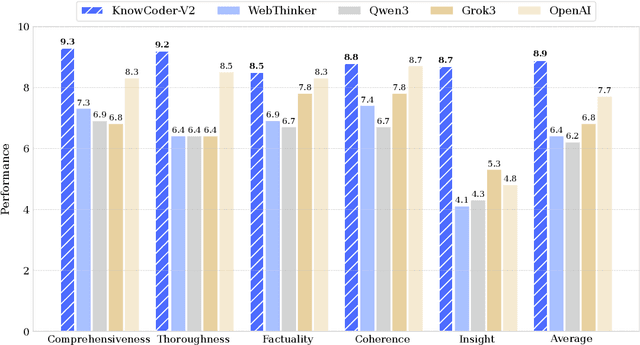
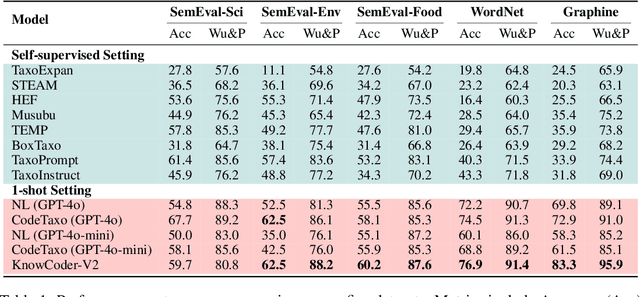
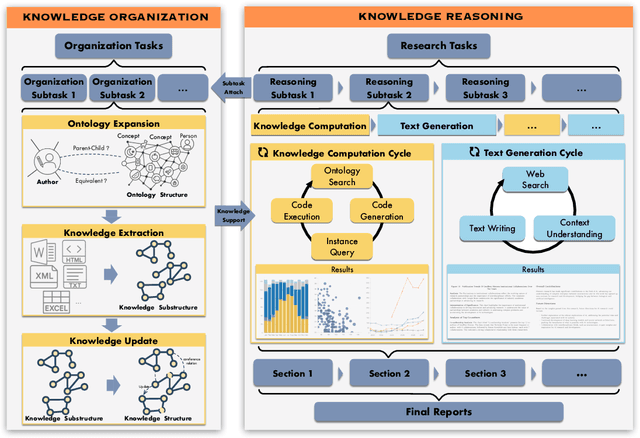

Abstract:Deep knowledge analysis tasks always involve the systematic extraction and association of knowledge from large volumes of data, followed by logical reasoning to discover insights. However, to solve such complex tasks, existing deep research frameworks face three major challenges: 1) They lack systematic organization and management of knowledge; 2) They operate purely online, making it inefficient for tasks that rely on shared and large-scale knowledge; 3) They cannot perform complex knowledge computation, limiting their abilities to produce insightful analytical results. Motivated by these, in this paper, we propose a \textbf{K}nowledgeable \textbf{D}eep \textbf{R}esearch (\textbf{KDR}) framework that empowers deep research with deep knowledge analysis capability. Specifically, it introduces an independent knowledge organization phase to preprocess large-scale, domain-relevant data into systematic knowledge offline. Based on this knowledge, it extends deep research with an additional kind of reasoning steps that perform complex knowledge computation in an online manner. To enhance the abilities of LLMs to solve knowledge analysis tasks in the above framework, we further introduce \textbf{\KCII}, an LLM that bridges knowledge organization and reasoning via unified code generation. For knowledge organization, it generates instantiation code for predefined classes, transforming data into knowledge objects. For knowledge computation, it generates analysis code and executes on the above knowledge objects to obtain deep analysis results. Experimental results on more than thirty datasets across six knowledge analysis tasks demonstrate the effectiveness of \KCII. Moreover, when integrated into the KDR framework, \KCII can generate high-quality reports with insightful analytical results compared to the mainstream deep research framework.
KnowCoder: Coding Structured Knowledge into LLMs for Universal Information Extraction
Mar 14, 2024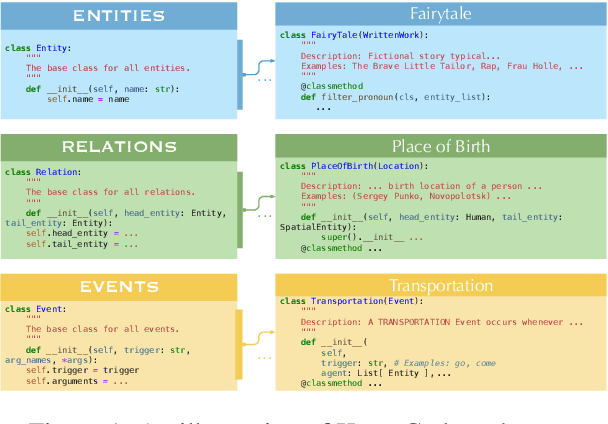

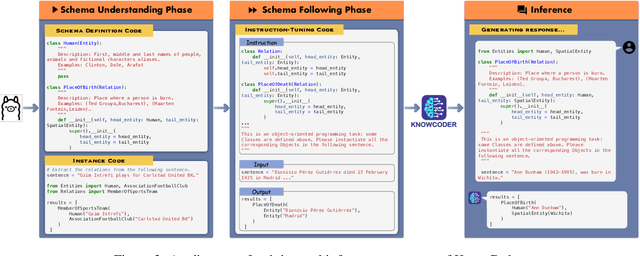
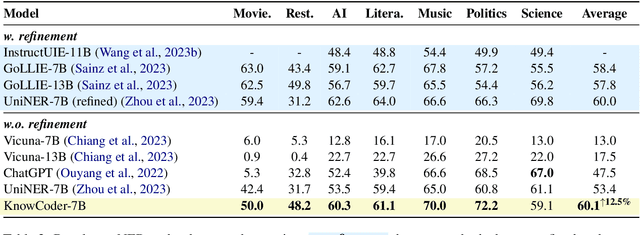
Abstract:In this paper, we propose KnowCoder, a Large Language Model (LLM) to conduct Universal Information Extraction (UIE) via code generation. KnowCoder aims to develop a kind of unified schema representation that LLMs can easily understand and an effective learning framework that encourages LLMs to follow schemas and extract structured knowledge accurately. To achieve these, KnowCoder introduces a code-style schema representation method to uniformly transform different schemas into Python classes, with which complex schema information, such as constraints among tasks in UIE, can be captured in an LLM-friendly manner. We further construct a code-style schema library covering over $\textbf{30,000}$ types of knowledge, which is the largest one for UIE, to the best of our knowledge. To ease the learning process of LLMs, KnowCoder contains a two-phase learning framework that enhances its schema understanding ability via code pretraining and its schema following ability via instruction tuning. After code pretraining on around $1.5$B automatically constructed data, KnowCoder already attains remarkable generalization ability and achieves relative improvements by $\textbf{49.8%}$ F1, compared to LLaMA2, under the few-shot setting. After instruction tuning, KnowCoder further exhibits strong generalization ability on unseen schemas and achieves up to $\textbf{12.5%}$ and $\textbf{21.9%}$, compared to sota baselines, under the zero-shot setting and the low resource setting, respectively. Additionally, based on our unified schema representations, various human-annotated datasets can simultaneously be utilized to refine KnowCoder, which achieves significant improvements up to $\textbf{7.5%}$ under the supervised setting.
ProtoEM: A Prototype-Enhanced Matching Framework for Event Relation Extraction
Sep 22, 2023Abstract:Event Relation Extraction (ERE) aims to extract multiple kinds of relations among events in texts. However, existing methods singly categorize event relations as different classes, which are inadequately capturing the intrinsic semantics of these relations. To comprehensively understand their intrinsic semantics, in this paper, we obtain prototype representations for each type of event relation and propose a Prototype-Enhanced Matching (ProtoEM) framework for the joint extraction of multiple kinds of event relations. Specifically, ProtoEM extracts event relations in a two-step manner, i.e., prototype representing and prototype matching. In the first step, to capture the connotations of different event relations, ProtoEM utilizes examples to represent the prototypes corresponding to these relations. Subsequently, to capture the interdependence among event relations, it constructs a dependency graph for the prototypes corresponding to these relations and utilized a Graph Neural Network (GNN)-based module for modeling. In the second step, it obtains the representations of new event pairs and calculates their similarity with those prototypes obtained in the first step to evaluate which types of event relations they belong to. Experimental results on the MAVEN-ERE dataset demonstrate that the proposed ProtoEM framework can effectively represent the prototypes of event relations and further obtain a significant improvement over baseline models.
Semantic Structure Enhanced Event Causality Identification
May 22, 2023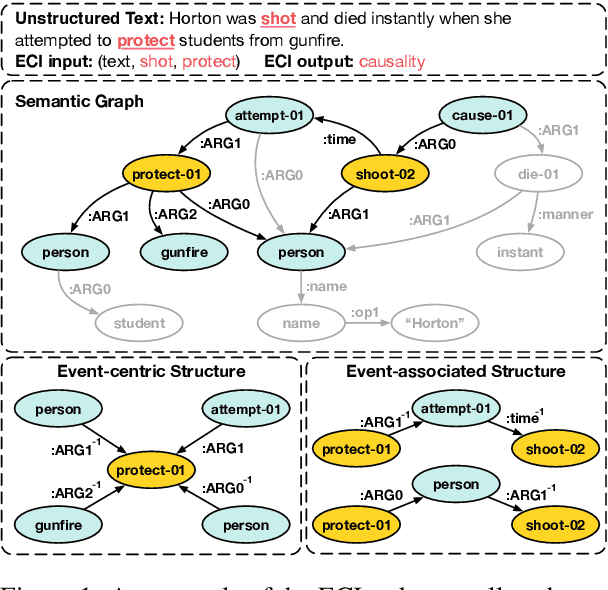
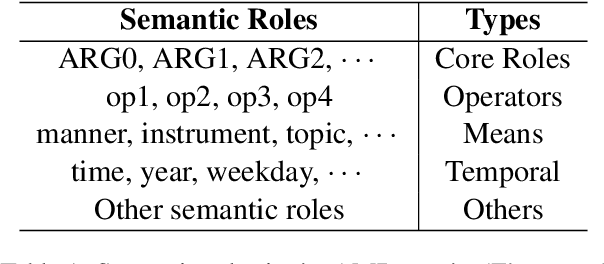
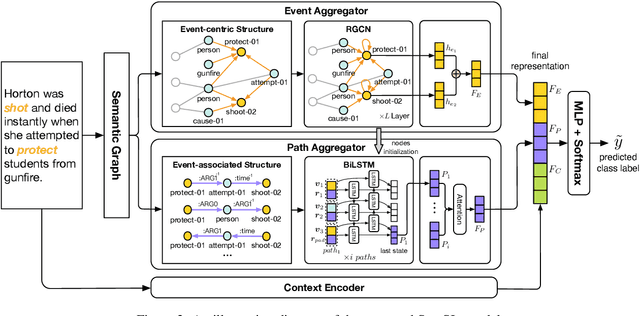
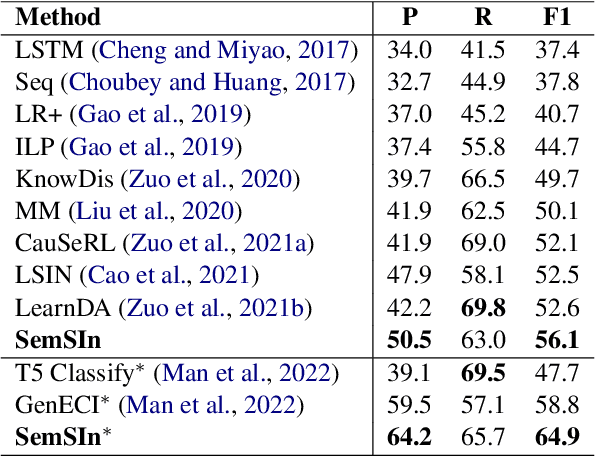
Abstract:Event Causality Identification (ECI) aims to identify causal relations between events in unstructured texts. This is a very challenging task, because causal relations are usually expressed by implicit associations between events. Existing methods usually capture such associations by directly modeling the texts with pre-trained language models, which underestimate two kinds of semantic structures vital to the ECI task, namely, event-centric structure and event-associated structure. The former includes important semantic elements related to the events to describe them more precisely, while the latter contains semantic paths between two events to provide possible supports for ECI. In this paper, we study the implicit associations between events by modeling the above explicit semantic structures, and propose a Semantic Structure Integration model (SemSIn). It utilizes a GNN-based event aggregator to integrate the event-centric structure information, and employs an LSTM-based path aggregator to capture the event-associated structure information between two events. Experimental results on three widely used datasets show that SemSIn achieves significant improvements over baseline methods.
 Add to Chrome
Add to Chrome Add to Firefox
Add to Firefox Add to Edge
Add to Edge